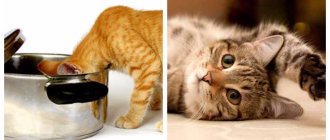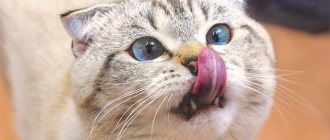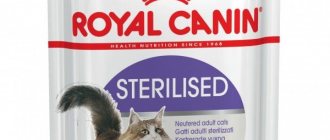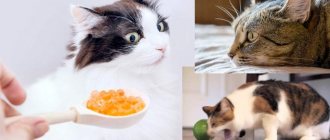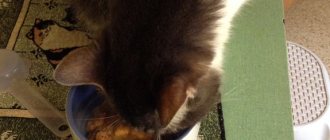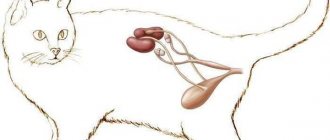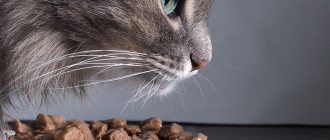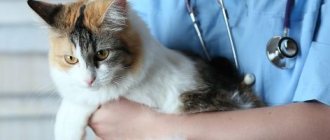Castration is a serious surgical intervention in the vital functions of an animal’s body. This is not just ridding the cat of sexual desire by removing the testicles. Such interventions have an impact on subsequent behavior, habits and functioning of the body. The owner needs to understand how to feed a castrated cat correctly, how to care for him, and what his needs are.
Changes in the body after castration
Domestic cats are castrated without asking their opinion, primarily to solve practical problems. An overly active and sometimes aggressive animal becomes calmer, sometimes even inert. In addition, the alpha male stops marking his territory, losing interest in the opposite sex. This helps get rid of the persistent “cat” odor, which in a sexually active cat is very unpleasant to human perception.
The testicles and gonads in cats perform the same functions as in other mammals, including humans. They produce sex hormones necessary for the stable functioning of the reproductive system. Their removal entails a serious hormonal imbalance. While the main restructuring is underway, the cat can remain active and continues to leave “marks.”
However, after some time, the owners notice that the animal has calmed down and no longer carries out night chases.
The cat, having lost its masculine strength, instinctively seeks a replacement. And most often it is found in food. And the owners, especially if they are worried, feel guilty for depriving the animal of “masculinity”, begin to intensively pamper the pet with various goodies. Coupled with the decrease in physical activity that occurs after castration, this regime leads to obesity. Therefore, owners need to pay increased attention to the cat’s nutrition after such an operation, because excess weight is the cause of the development of many diseases.
In addition to obesity, cats are also at risk for other health problems. The most likely danger of neutered cats is the development of urolithiasis. The fact is that after the operation, not only the hormonal balance is rearranged, changes also occur at the physical level.
The genitourinary system begins to function somewhat differently: in particular, a slight narrowing of the urethra occurs. Such changes especially affect kittens whose testicles were removed at an early age, before six months, when the organs of the genitourinary system have not yet fully developed.
In general, according to veterinarians, it is most optimal and correct to carry out castration at the age of eight months to a year. To avoid psychological trauma, the animal should not have sexual contact before surgery.
Having once experienced the joys of sexual life, having realized the instinct of procreation, the cat will no longer forget the experience gained and will suffer greatly. Of course, there are different situations, sometimes it is necessary to castrate adult cats. However, those who have a tailed pet need to immediately resolve the issue of castration and do everything in a timely manner, this will significantly reduce the likelihood of problems in the future.
The development of urolithiasis is always associated with poor nutrition. If there is a lot of phosphorus, magnesium and calcium in food, this contributes to the formation of sand and stones in the kidneys and other organs of the genitourinary system, since these elements are not completely eliminated, but settle in the form of salts.
Owners who have sterilized their cat need to pay great attention to their pet’s diet, as well as the size of portions and frequency of feeding, in order to prevent the development of possible diseases.
Purchased feed options
Fortunately, special foods have long been developed and are widely distributed that will take care of your pet’s proper nutrition. We strongly do not recommend feeding a neutered cat with dry food that is not intended to protect the genitourinary system! It should be taken into account that the ready-made food that a cat needs after castration is not in the low or medium price segment, because medicinal food is included in the “premium” class and has an appropriate price.
Super premium food
Super premium food is in the high price segment. They contain all the necessary components that will ensure proper nutrition for the cat. It should be noted that often the composition of Super Premium class food may not differ at all from Premium class food, but has greater demand and, accordingly, price. The meat component of Super premium food should weigh no more than 28% and no more than 54% of the total weight of the product.
Here are the Super Premium food series that have proven themselves well on the market:
- "Innova EVO" - has certified ingredients. This line of expensive food is an alternative to natural nutrition. The food contains: cartilage, bones, fat, turkey. The food will provide the cat’s body with the necessary amount of calcium and collagen.
- “Hills” - contains a low amount of substances that are dangerous due to addiction. The food contains: flax seeds, tuna fish, poultry. This Super Premium food is the best weight control formula.
- “1st Choice Indoor” is a high-quality and relatively inexpensive food in its segment. In this line you can find food that differs from each other depending on the purpose for a particular pet’s character. The composition has the following components: tea, rice, seaweed, poultry, dried pineapple and other useful ingredients.
- “Eukanuba” has several varieties: special, medicinal, for mature and elderly cats. This food contains: eggs, liver, chicken meat. The peculiarity of this food is that it contains components that strengthen the coat, control weight and reduce the risk of urolithiasis.
- "Eagle Pack" - satisfies all age criteria for feeding animals, and is available in the form of granules. The composition has a large number of components: lamb fillet, chicken fat, fish, blueberries, lingonberries, powdered fruits. In addition, to ensure that the castrated cat’s health is normal, the product contains: fiber, protein, vitamins, omega 3 and 6, taurine.
Premium food
These foods are in a lower price category when compared with Super premium foods. Usually they are no worse and are just as popular among owners of furry pets. The meat component is approximately the same as Super Premium food.
Here are the best food lines that represent Premium food:
- Royal Canin is one of the best dietary foods for cats in this class. Ingredients: poultry, wheat, corn, rice, soybeans. In a number of this line you can find food that is aimed at combating some common diseases in cats.
- Purina Pro Plan is one of the best foods that improve metabolism in neutered cats. The food contains: turkey, chicken, vitamins, grains and omega acids. The food has a special feature - ensuring the removal of hair from the pet's body.
- “Hills” is distinguished by high-quality natural ingredients and taste. Ingredients can be found: flaxseeds, barley, oats, fish, animal fat, poultry meal, spinach, oatmeal. In this line you can find the best dietary foods.
Feeding after surgery
Your doctor will tell you how to feed your cat immediately after surgery. Usually, after anesthesia, it is recommended not to give the animal food immediately (and he most likely will not want to). There should be enough water, because after anesthetic medications the cat may feel thirsty.
When the animal completely recovers from anesthesia and asks for food, you can give it a little kefir, a weak meat broth.
You should not give solid food right away. It is also impossible to infuse it by force: the animal itself knows what it needs.
On the second day, you can give food to which the cat is already accustomed. Sudden changes in diet will harm both psychologically and physically. The cat should be transitioned to a new diet gradually. If a pet lives in a house from an early age, and the decision to castrate is made in advance, it is better to initially accustom it to certain foods. Then after surgery you will not need to make changes to your diet.
For several days after surgery, it is necessary to exclude fatty foods from the diet (for example, do not give sour cream, fatty fish or meat). The protein component should be strengthened. Fatty foods are generally harmful, but sometimes you can pamper your pet, but not often. Protein is simply necessary for a predator.
The cat should be gradually transferred to a new diet so that he does not experience psychological stress and problems with the gastrointestinal tract. After surgery, veterinarians recommend supporting the animal’s body by conducting a vitamin and mineral course.
The drug Gamavit helps to recover well. This complex product containing vitamins, amino acids and healthy salts is made on the basis of a growth nutrient medium.
Video “How to feed cats correctly”
If you have a pet or are just planning to get one, you will find it very useful to get advice on how to properly feed it with store-bought or natural food prepared at home. This video explains in detail how much food to give your cat and at what intervals to feed it.
Was this article helpful?
Thank you for your opinion!
The article was useful. Please share the information with your friends.
Yes (66.67%)
No (33.33%)
X
Please write what is wrong and leave recommendations on the article
Cancel reply
Rate the benefit of the article: Rate the author ( 5 votes, average: 4.80 out of 5)
Discuss the article:
Nutritional features of a castrated cat
Cats get used to a certain lifestyle, including feeding schedules. Any disruption to the usual course of events can cause them stress. Therefore, from an early age, if possible, it is necessary to accustom your pet to a certain style of feeding.
The following rules should be followed:
- You cannot feed natural food and prepared food at the same time. If a cat is accustomed to a natural diet, he can, of course, occasionally be pampered with ready-made food, but constantly giving two types of food is strictly prohibited. This is due to the fact that industrial feed contains the entire necessary set of nutrients, taking into account the age and individual characteristics of the animal. They are developed in such a way that the cat’s body receives everything it needs. If such food is mixed with natural products, there is a high risk that some nutrients will be deficient and others will be in excess.
- Cat food should be warm (but not hot).
- It is recommended to feed the cat 3-4 times a day. There must be a certain schedule that the animal will get used to. Although cats do not know how to use a watch, they clearly know the usual feeding time.
- The place where the cat eats must be permanent. It is advisable to choose a quiet corner where the animal will feel safe and no one will distract it from eating. If there are several pets in the house, then you need to make sure that they do not interfere with each other, and each of them can safely eat their food.
- If the cat has a natural diet, then after eating it is necessary to clear it “from the table”. Protein food gets exposed to air, loses its properties, and simply spoils. The diet should consist of 80% protein, since the cat’s gastrointestinal tract is adapted to digesting soft meat fibers and does not tolerate coarse plant fibers well.
- If a neutered cat is fed ready-made food, you should stick to one brand of food. The main diet should be dry food, wet food should be given less often, about once a day.
Cat food manufacturers that have proven themselves on the market usually produce special lines of food designed specifically for neutered cats. They have a reduced content of phosphorus, calcium and magnesium. You can also choose food designed for young or old animals with short or long hair.
Proper selection of food will help provide your pet’s body with all the necessary substances without causing harm to it.
About mixing feed
Many owners, seeing that the cat is not eating enough, try to diversify the diet as much as possible in order to somehow satisfy the glutton. They use raw meat, cutlets from the master's table, wet food and dry food... This is fundamentally wrong. Diversity is welcomed only within the framework of a specific food system. For example, if a cat eats raw meat with vegetables, then as part of a raw food diet it is possible and even necessary to serve different types of meat and offal. But you should not mix two different nutrition systems (natural and factory feed) or constantly change the types of factory feed.
Many arguments can be made against a mixed diet, but we will dwell on one, which is related to the problem of appetite, in more detail. Studies have been conducted that have found that the cat’s body better senses the norm of food when it is fed consistently with approximately the same foods. The process starts within 2-3 days from the moment of switching to a specific diet and is completely stabilized within 3-4 weeks.
That is, if for a month a cat receives only natural products in the same quantity and in the same form (for example, raw meat and offal + 10% of the diet in the form of vegetables), then the body gets used to this situation and learns to regulate consumption energy during the day in accordance with what you eat, and also regulate food intake. And vice versa: frequent changes in food types and daily intake violate this ability. This feature is clearly visible in the example of pets whose owners indulge in constant change and combination of food - the metabolism of such cats is disrupted and excess weight makes itself felt.
Prohibited Products
There are a number of products that can cause serious damage to the health of a pet after castration. First of all, no cat in the world is suitable for food from the human table. The presence of salt, seasonings, and other additives is strictly contraindicated for animals.
In addition, some heat treatment methods are also prohibited for feeding a cat. These are, of course, fried foods containing a large amount of fat.
Also, you should not feed a neutered cat the following foods:
- fatty varieties or parts of meat;
- fish of any kind;
- sweets, confectionery;
- any sausages;
- smoked products;
- bread, pasta;
- legumes, corn;
- soy products;
- pickles, pickled vegetables.
Cereals can be given to cats in small quantities, in the form of porridge. The exception is semolina.
It is unacceptable to choose unsuitable industrial food, for example, feeding a neutered cat products that are not intended for him. It is necessary to choose premium brands. Only high-quality nutrition can provide the animal’s body with all the necessary elements and substances.
Prohibited Products
Experts have different views on milk. Almost half of domestic cats are lactose intolerant. If a castrated cat does not have this problem and laps up milk with pleasure, then there is no strict prohibition on consuming the whole product. However, milk contains a lot of calcium, and the intake of this element after castration should be limited.
Allowed homemade food
Despite the not so large list of foods allowed for food, a neutered cat can be fed quite variedly. In this case, you need to alternate the products used, mix them, come up with your own recipes for cat cuisine and feel free to experiment with acceptable ingredients.
© shutterstock
To fully obtain all the necessary vitamins and microelements after castration, your pet’s diet should include:
- fermented milk products (low-fat curds, cream, sour cream, sometimes kefir), but completely avoid feeding with milk;
- sprouted independently or purchased at a pet store greens of barley, wheat or oats;
- vegetables, especially carrots, cauliflower, cucumbers (raw grated or boiled), but exclude nightshades, garlic and onions in any form from the diet;
- cereals (wheat, oatmeal, corn, rice plus semolina and buckwheat);
- liver, heart, kidneys, stomachs - not daily, but at certain intervals (for example, feeding with liver - once every 1-2 weeks);
- lean meat, cut into pieces (veal, beef, chicken, turkey), frozen before feeding.
Yes, neutered cats can only eat so much (in terms of dietary diversity), and they do not eat every product listed with pleasure. For example, porridge in its pure form is unlikely to delight an animal . Therefore, it is better to approach the issue of feeding creatively and come up with interesting options on the topic “My cat’s menu.”
How to create a proper and varied menu
The diet of a neutered cat should under no circumstances include food from the owners’ table. Few people eat completely unsalted food, and rare people deprive themselves of smoked meats, fatty foods, sweets and other “harmful” foods for a cat after castration.
This leads to the first and indisputable rule: the animal’s nutrition must be individual!
But at the same time, as already mentioned, it is possible and necessary to feed a castrated cat at home in a variety of ways in order to saturate his body with everything necessary. What food options can you offer your furry pet:
- Vegetables with meat . It’s rare that a cat will agree to gnaw carrots separately, so grated, permitted vegetables will perfectly complement a meat dish. If you mix them, you get a healthy and tasty meat and vegetable stew.
- Greenery . As necessary, the cat itself will come up and “pinch” the grass growing on the windowsill. But you can readily offer your pet chopped “green stuff”, mixing it with the same meat and vegetables.
- Porridge . It’s not a cat’s favorite food, so you need to know how to cook it. It is better to cook cereals in meat broths; you can mix porridge with meat pieces. And if you add some vegetables here, such feeding will be three times useful.
- Meat . It can be given however you like: with vegetables, cereals or separately. If you offer castrated cats meat in its pure form, it is better to serve it with broth: the juicier and thinner the food, the easier the liquid is washed out of the castrate’s narrowed urinary tract.
- Milk . There are fewer options regarding dietary diversity here. But some cats happily eat cottage cheese mixed with herbs. The main thing is that fermented milk products are not sweet and do not contain foreign additives.
- Offal . Feed them according to the same principle as meat: mix with vegetables and cereals. But you should not give them to a cat after castration more than once every 1-2 weeks.
- Fish . For castrated pets, this is a prohibited product and cannot be given in the system, but once every 2 months it is allowed to pamper your pet with a small portion. But in order to cause even less harm to the cat, you can cook porridge in fish broth, and then the smell of the fish adored by all cats will do its job.
Proper feeding of a cat after castration and preparing a diet from homemade products is not a difficult task, if only you had some imagination and some time for cooking. But with industrial feeds the situation is much simpler, although such nutrition has its own nuances.
© shutterstock
What to choose: ready-made food or natural food
Felinologists and veterinarians do not have a consensus on which food is better: natural or industrially produced. The owners must decide for themselves on this issue. Most people today prefer the latter option as it is much more convenient. There is no need to cook for your pet, and the costs are about the same.
The only thing that all experts agree on is that human food is not suitable for cats, whether neutered or not.
Ready-made food is good because it contains all the necessary nutrients, vitamins and elements. By choosing the right food from a good manufacturer, you can be sure that your pet’s body receives a balanced set of compounds that is suitable specifically for its individual characteristics. With this feeding, there is no great need to give the cat vitamin supplements. True, vitamin courses are periodically recommended for large and long-haired animals.
Many experts are supporters of a natural diet. This is explained by the fact that the animal better assimilates food that it can obtain in natural conditions. A cat cannot catch a mouse or a bird in an apartment, and its owners certainly will not do this on the street. But meat is meat, and this product should form the basis of a cat's diet. You should choose low-fat varieties. It is better not to give it raw; boiled meat is best. Meat by-products are also beneficial for a cat’s body.
The predator's digestive tract hardly digests cereals and plant fibers. You can diversify your diet with porridges made with meat broth, but you should not give such food too often.
Starchy vegetables with a high glycemic index are also not suitable for feeding a neutered cat.
The diet should contain dairy products (low-fat cottage cheese, kefir, yogurt, low-salt cheeses). You can sometimes give your animal chicken or quail eggs.
Specialized stores sell special pots of lawn grass. Many cats love to nibble on this kind of grass, getting the necessary substances from it.
With a natural diet, it is necessary to take a course of vitamin and mineral supplements at least twice a year in order to maintain the animal’s immune status at the proper level.
Be sure to read the article about vitamin deficiency in cats; this problem is especially relevant for neutered animals.
TOP 12: RANKING OF THE BEST FOOD FOR BRITISH CATS
Food rating for the British:
- Orijen – 80% protein, 20% vegetables and fruits
- Acana – 70% protein, 30% vegetables and fruits
- Wildfield – 60% protein, 40% vegetables and fruits
- Farmina – grain-free food + probiotics, medicinal herbs
- Trainer – food for animals with sensitive digestion, kidney problems, etc. These foods help maintain health. Suitable for animals with gluten intolerance. Products for processing into feed are steamed.
- Science Plan (Hills) is a good food for everyday nutrition, well digestible, does not cause allergies, natural antioxidants and preservatives, a wide range of feeds, excellent distribution.
- Bosch cellulose and maize additives are harmful and can cause allergies.
- OK Passion – not suitable for sensitive cats
- Purina ProPlan - high in protein, rice is used as a cereal, but wheat flour is still added. Probiotics.
- Royal Canin (Royal Canin) - there is an everyday line and a medicinal one. Everyday series - a lot of preservatives (the Russian line of food is not recommended, it is better to give preference to the French one). The medicinal series is perfectly balanced and has good reviews from veterinarians and has a healing effect.
- Premil – additives and flavor enhancers. No gluten.
- Josera - Overall a good food, it rarely causes allergies, it contains corn gluten.
*All these foods contain minerals, vitamins, and beneficial additives.
The material is for informational purposes only, presented solely as an example for comparison.
Take proper care of your pets and choose the best food for them!
Mr. Cat recommends: feeding regimen
After surgery, it is not recommended to change either your diet or feeding regimen. The animal has already suffered stress; there is no need to create additional difficulties for it. Experts recommend feeding the animal two or three times a day.
If the cat eats ready-made food, then you can leave the daily portion in a bowl, and the animal will eat when it wants. However, this option may not be suitable for those whose cat is prone to overeating. Having finished the daily requirement in one or two sittings, by the evening he will begin to pester his owner with requests to feed him. In such cases, it is better to divide this amount by the usual number of feedings and give strictly dosed amounts of food in a timely manner.
With a natural diet, it is recommended to remove food immediately after the meal so that it does not spoil. Every meal you need to give your cat freshly prepared food.
How much food to give a cat per day with a mixed diet?
With a mixed diet (is it possible, in principle, to feed a cat dry and wet food at the same time?) it is better to feed cats products from the same manufacturer or even the same line. Firstly, such a recommendation is given by veterinarians, and secondly, in this case you will always know exactly how much and what kind of food the animal should eat, since all the recommendations are given on the manufacturer’s labels.
When the manufacturers of wet and dry food are different, you will have to calculate the volume of food yourself and experiment. The starting point could be, for example, half the daily value of wet and the same amount of dry product. Next, you should monitor your pet. If he loses weight, then the portions need to be increased; if he gains weight, then, on the contrary, he should reduce them.
